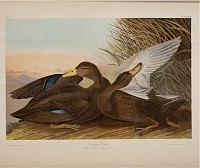BIOGRAPHY

1785-1851
John James Audubon was an American ornithologist, naturalist, and painter. After trying and failing in several different types of business ventures, he concentrated on drawing and studying birds, and began traveling around the country to pursue this work. He was notable for his extensive studies documenting all types of American birds and for his detailed illustrations that depicted the birds in their natural habitats. His major work, a color-plate book entitled The Birds of America (1827–1839), is considered one of the finest ornithological works ever completed. Audubon discovered 25 new species and 12 new subspecies. Audubon developed his own methods for drawing birds. First, he killed them using fine shot. He then used wires to prop them into a natural position, unlike the common method of many ornithologists, who prepared and stuffed the specimens into a rigid pose. When working on a major specimen like an eagle, he would spend up to four 15-hour days, preparing, studying, and drawing it. His paintings of birds are set true-to-life in their natural habitat. He often portrayed them as if caught in motion, especially feeding or hunting. This was in stark contrast to the stiff representations of birds by his contemporaries. Audubon's influence on ornithology and natural history was far reaching. Nearly all later ornithological works were inspired by his artistry and high standards. Charles Darwin quoted Audubon three times in On the Origin of Species and also in later works.
1826-1909
Julius Bien was an American lithographic printer and cartographer who worked in New York City in the second half of the 19th century. He was responsible for the publication of thousands of maps issued by the U.S. government and private map publishers. He was a pioneer in the development of chromolithography. He is recognized as one of the finest map printers of his time. Bien's printing and publishing of geological maps was outstanding and he took geological visualizations to new levels. Bien was born in Naumburg, Germany in 1826 and was educated at the Academy of Fine Arts in Cassel and at Stadel's Institute in Frankfurt. He became involved with the German revolution of 1848, which led to his immigration to America in 1849. He established a lithographic business in New York City in 1850 and continued it there for over 50 years. By the time of Bien's death in 1909 his innovations in printing technology had been recognized by numerous awards and his election as the first president of the National Lithographers Association. His prolific cartographic output during his lifetime included all the U.S. western surveys, the U.S. Census, the coast surveys, the Pacific Railroad Surveys, Civil War maps, and several atlases that he published himself.
